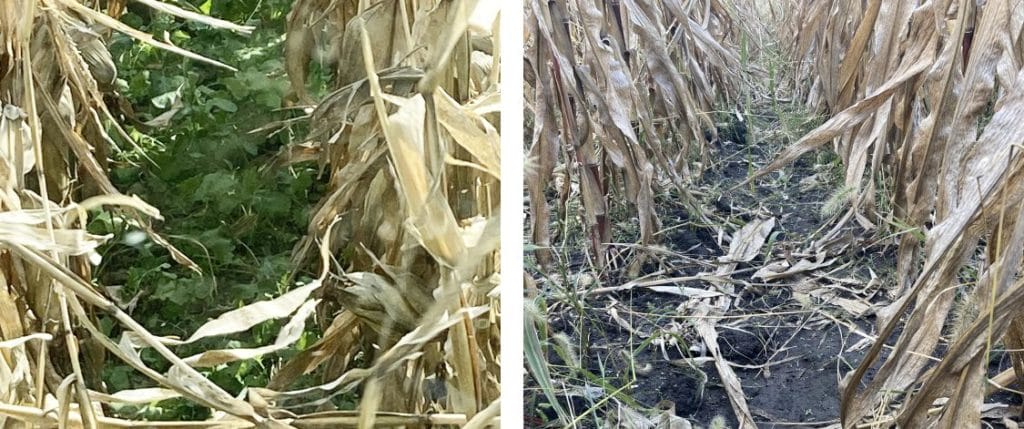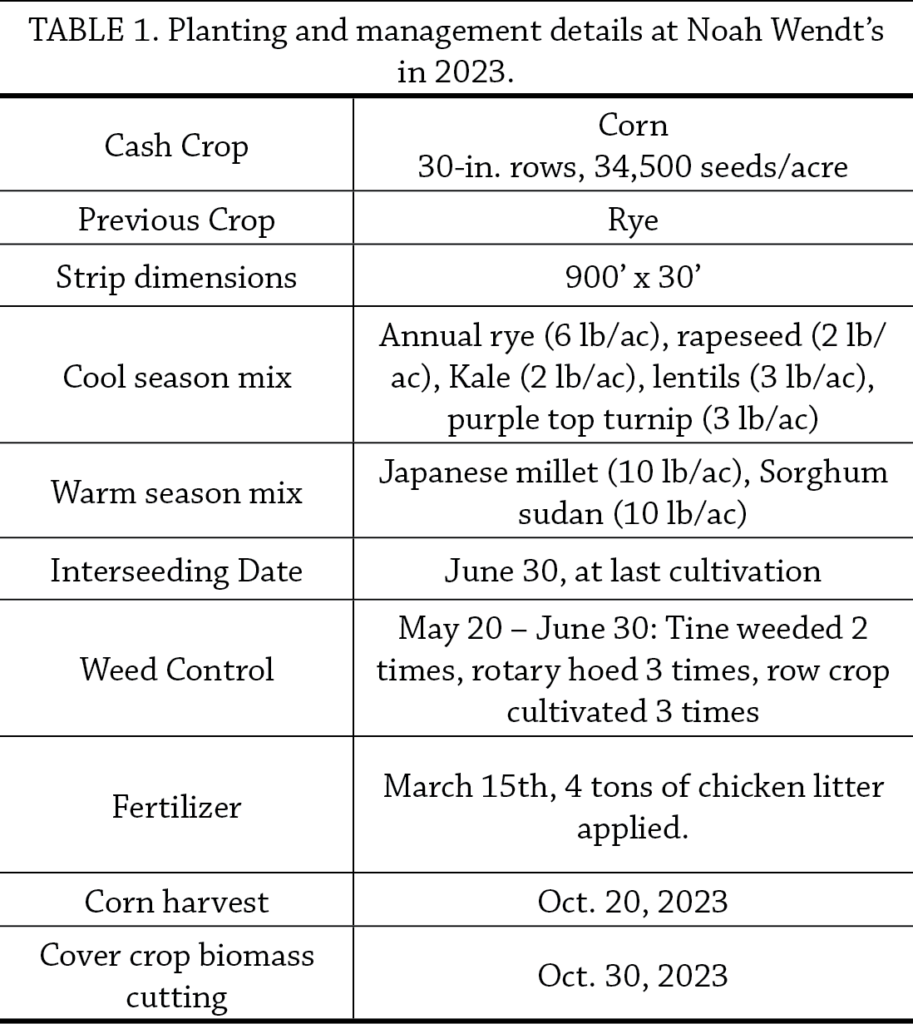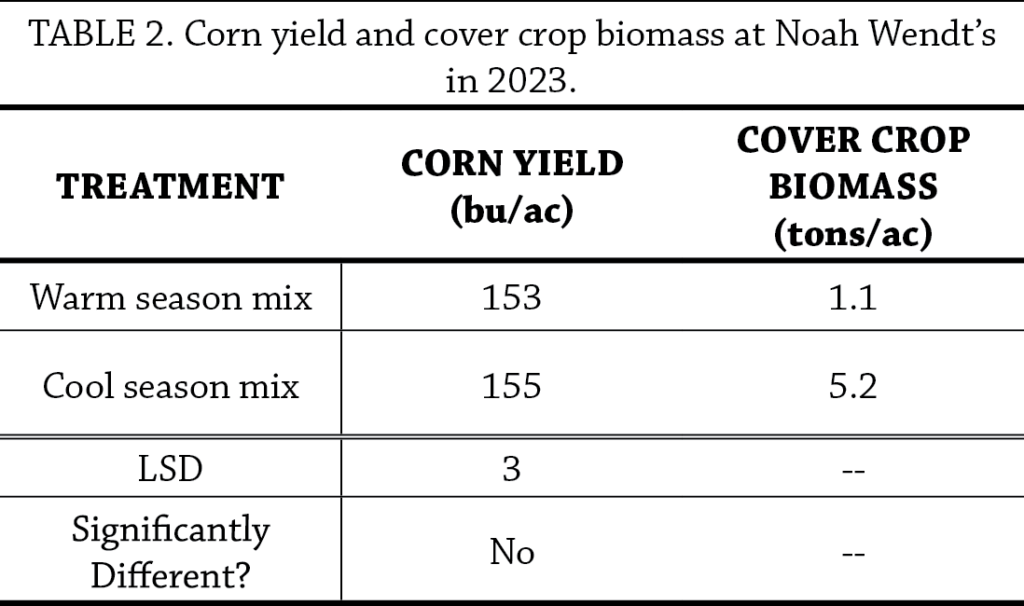This research report was funded by USDA NRCS; Walton Family Foundation.
In a Nutshell
- Interseeding cover crops into standing corn is a growing practice that allows cover crops to establish earlier in the season and opens earlier grazing opportunities.
- Cooperator Noah Wendt investigated the corn yield and fall forage potential effects of interseeding a diverse, cool-season cover crop mix vs. a warm-season sorghum-millet mix in his organic corn field.
Key Findings
- Wendt’s diverse cool-season cover crop mix produced an estimated 5.2 tons/ac of biomass while the sorghum-millet treatment produced only 1.1 tons/ac.
- Cover crop mix did not affect corn crop yield.

Noah Wendt’s diverse cover crop mix (left) outproduced his sorghum-millet mix (right). Photo taken September 2023.
Background
Interseeding cover crops into corn is the practice of planting cover crops between rows of standing corn when the corn is big enough that cover crop does not compete with it but before the canopy closes, usually between the V4 and V6 phases [1]. Establishing cover crop earlier in the season maximizes fall growth and can allow for earlier cover crop grazing, an exciting prospect in colder climates such as Iowa when the season for cover crop growth after corn harvest is quite short. Previous research in North Dakota, South Dakota and Iowa has found that interseeding cover crop in corn at V4 stage and later does not affect corn yield [2,3,4], though on-farm research in Nebraska has shown that early-stage interseeding (V3-V5) can sometimes negatively affect corn yield [5].
Noah Wendt decided to investigate the effects of interseeding several different cover crop mixes on his organic corn crop yields and fall cover crop forage potential. Wendt has already been practicing interseeding a cool-season cover crop mix into his corn at last cultivation but was curious about warm-season seed mix options and wanted to home in on “what forage works best for interseeding corn.”
Methods
Design
Wendt established interseeding treatments at last cultivation of corn in randomized, paired strips with four replications: 2 treatments x 4 replications = 8 strips total. Planting details and management information are shown in Table 1.
Measurements
Wendt recorded grain yield and moisture from each strip using a yield monitor. He also collected aboveground cover crop biomass 10 days after harvest from nine square-feet in one of each strip, dried, and weighed them for cover crop biomass calculations.
Data analysis
To evaluate effects of the treatments on corn yield we calculated treatment averages for each measurement then used a t-test to compute the least significant difference (LSDs) at the 95% confidence level. The difference between each treatment’s average corn yield is compared with the LSD. A difference greater than or equal to the LSD indicates the presence of a statistically significant treatment effect, meaning one treatment outperformed the other and the farmer can expect the same results to occur 95 out of 100 times under the same conditions. A difference smaller than the LSD indicates the difference is not statistically significant and the treatment had no effect. We could make these statistical calculations because Wendt’s experimental design involved randomization and replication of the treatments (Figure A1).
Results and Conclusions
Cover crop mix treatment did not affect corn yield but there were drastic differences in biomass produced in the two treatments. though, we were not able to perform statistical analysis because too few biomass samples were collected (Table 2). Diverse cover crop mix produced an estimated 5.2 tons/ac of biomass while the sorghum-millet treatment produced only 1.1 tons/ac. The diverse, cool season seed cost $30/ac while the sorghum/milled warm season seed cost $25/ac, but increased forage production by the cool season mix more than paid for this difference in seed cost. Wendt reports that these results will likely influence his farming practices and he will likely stick with the cool season mix.
Appendix – Trial Design and Weather Conditions

Figure A1. Example experimental design used by Noah Wendt in 2023.

Figure A2. Weather data from the 2023 growing season and 10-year climate averages at Ames near Huxley, IA [6]. Left graphs show monthly precipitation accumulation in 2023 vs. 10-year normal and right graphs show monthly average temperature in 2023 vs. 10-year normal. Click to enlarge.
Funding Acknowledgements
This material is based upon work supported by the U.S. Department of Agriculture, under agreement number NR226114XXXXG004. Any opinions, findings, conclusions, or recommendations expressed in this publication are those of the author(s) and do not necessarily reflect the views of the U.S. Department of Agriculture. In addition, any reference to specific brands or types of products or services does not constitute or imply an endorsement by the U.S. Department of Agriculture for those products or services.
References
[1] “Interseeding into Corn.” Iowa NRCS, Mar. 2022. Accessed: Jul. 20, 2023. [Online]. Available: https://www.nrcs.usda.gov/sites/default/files/2022-09/InterseedingCCIntoCorn.pdf
[2] E. Antosh, M. A. Liebig, D. W. Archer, and R. Luciano, “Cover crop interseeding effects on aboveground biomass and corn grain yield in western North Dakota,” Crop Forage Turfgrass Manag., vol. 8, no. 1, p. e20148, 2022, doi: 10.1002/cft2.20148.
[3] J. Clark, S. Osborne, P. Sexton, and P. Kovács, “Interseeding Cover Crops Effect on Corn and Soybean Production: 2019.” South Dakota State University Extension, Aug. 2020. Accessed: Jul. 20, 2023. [Online]. Available: https://extension.sdstate.edu/interseeding-cover-crops-effect-corn-and-soybean-production-2019
[4] S. Gailans, J. Boyer, and D. Sloan, “Interseeding Cover Crops to Corn,” Practical Farmers of Iowa, 2022. Accessed: Jul. 20, 2023. [Online]. Available: https://practicalfarmers.org/research/interseeding-cover-crops-to-corn/
[5] J. Rees, S. Melvin, L. Thompson, T. Lexow, K. Koehler-Cole, and M. Drewnoski, “On-Farm Research Early-season Interseeding into Corn and Soybean Results (2019-2022).” University of Nebraska Lincoln Cropwatch, Apr. 13, 2023. Accessed: Jul. 20, 2023. [Online]. Available: https://cropwatch.unl.edu/2023/farm-reseach-early-season-interseeding-corn-and-soybean-results-2019-2022
[6] Climodat Reports, “Iowa Environmental Mesonet.” Iowa State University. [Online]. Available: http://mesonet.agron.iastate.edu/climodat/



